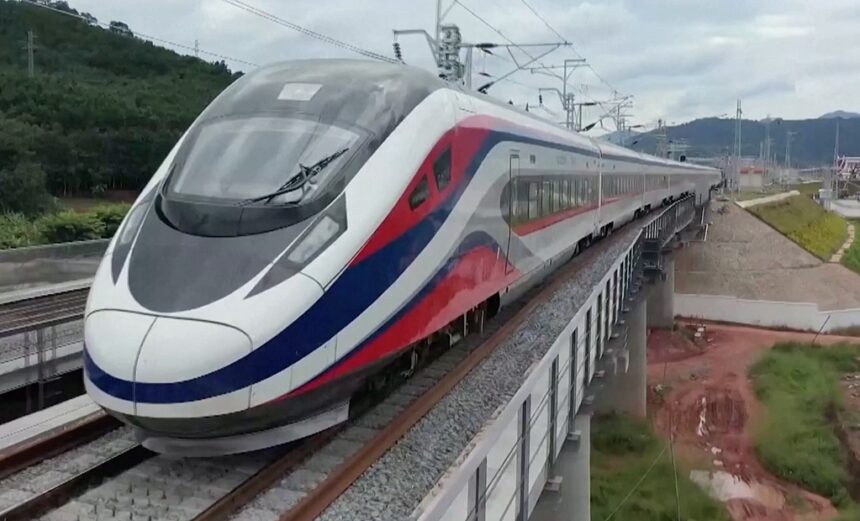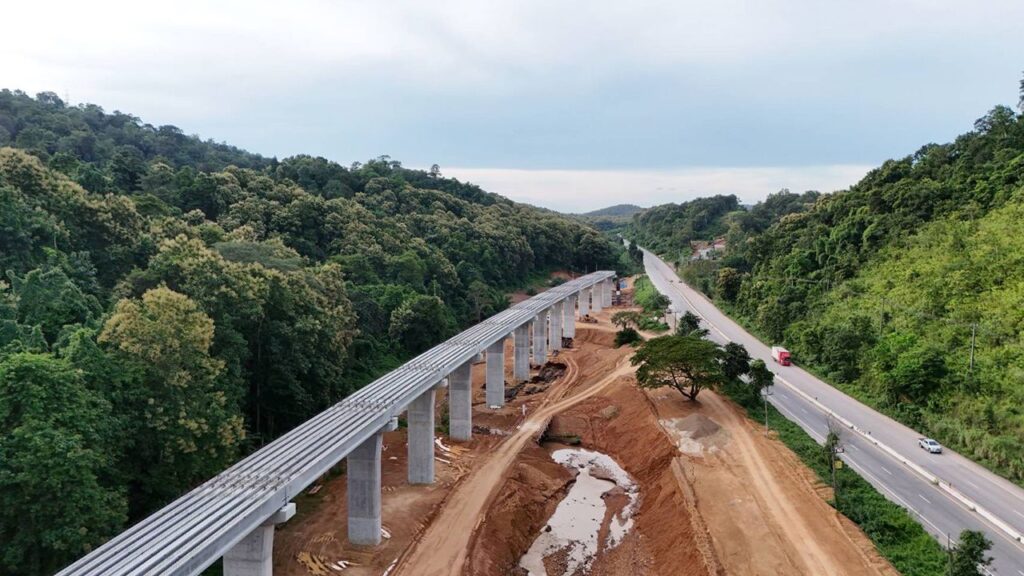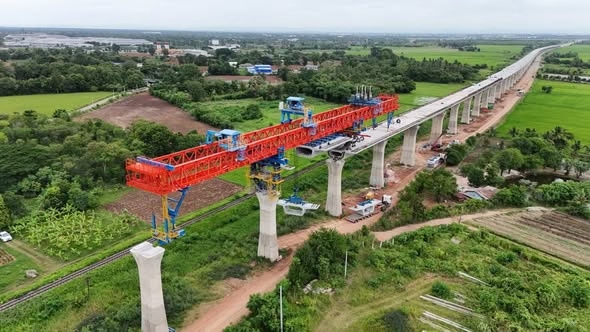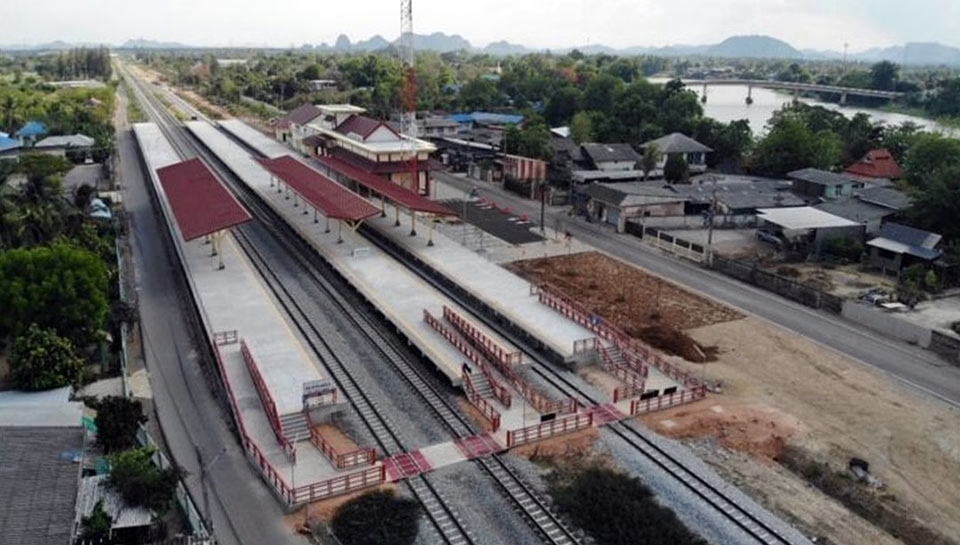BANGKOK – The rhythm of steel on steel is fast becoming the soundtrack of Thailand’s next chapter. For years, the rail network lagged behind a growing economy. That picture is shifting, quickly and decisively.
A vast, multi-trillion-baht programme is moving ahead, laying modern rail lines at a scale the country has never seen. These are not small fixes or patchwork upgrades. They are new arteries set to move Thailand away from clogged highways and towards a rail-led transport system that supports its role as a logistics hub for mainland Southeast Asia.
The deepest changes will be felt across the North and the far Northeast, regions often left behind by Bangkok-first planning. Four megaprojects, two high-speed routes, and two double-track lines cut through old barriers, lower transport costs, and plug Bangkok directly into Laos, China, and Malaysia.
For families in Chiang Rai, growers in Phrae, and business owners in Nong Khai, this is not theory. It is an opportunity made real, backed by steel and concrete. This guide covers the four rail projects reshaping Thailand’s economy and strengthening links across ASEAN.
1) The Northern Gambit: Den Chai – Chiang Rai – Chiang Khong Double Track
Chiang Rai has waited more than sixty years for a railway. That wait is ending. The Den Chai – Chiang Rai – Chiang Khong double-track line is both emotional for the North and central to long-term planning. Branching from the Northern Line at Den Chai in Phrae, this 323-kilometre route, priced at 72.9 billion baht, will serve Phrae, Lampang, Phayao, and Chiang Rai, finishing at the border town of Chiang Khong.
This is far more than a new passenger link, though faster trips to Bangkok will help tourism. The real draw lies at the terminus. Chiang Khong connects to the Lao PDR via the Fourth Thai-Lao Friendship Bridge, tying into freight routes toward southern China. New intermodal facilities at Chiang Khong show the intent. The line is built to move cargo at scale. By shifting freight from road to rail, logistics costs for northern producers and exporters should fall.
Progress has not been simple. Tendering issues and difficult terrain call for four major tunnels, including a 6.24-kilometre tunnel in Ngao district that would be the country’s longest. Even so, the State Railway of Thailand reports steady construction across three main contracts and targets completion in 2028. The alignment threads through mountains and river valleys, promising one of Thailand’s most scenic rides. Tourism stands to gain, and the northern economy gains another pillar alongside agriculture.
2) The Trans-Asian Nexus: Thai-Chinese High-Speed Railway, Bangkok to Nong Khai
The Thai-Chinese High-Speed Railway is Thailand’s largest single rail project and a centrepiece of regional rail plans. Starting at Krung Thep Aphiwat Central Terminal in Bangkok and running to Nong Khai, the line will slot Thailand into a wider high-speed network. In time, passengers could travel from Bangkok to Kunming via the China-Laos Railway.
The project is split into two phases:
- Phase 1, Bangkok to Nakhon Ratchasima, covers 253 kilometres with a budget of about 179 billion baht. Work started in 2017 and has faced persistent delays. By early 2025, the build stood near 36 percent. The current target for opening is 2028.
- Phase 2, Nakhon Ratchasima to Nong Khai, won Cabinet approval in early 2025. This 357-kilometre section carries an investment of about 341 billion baht, with operations expected by 2030 or 2032.
The service will use Fuxing Hao CR300AF trains from China, operating at up to 250 km/h in Thailand. A new bridge over the Mekong at Nong Khai will connect to the Vientiane-Boten corridor of the China-Laos Railway.
The economics are clear. Travel times between Bangkok and Isaan drop sharply, opening the Northeast to more trade and tourism with China and boosting Thailand’s position as the key connector in mainland Southeast Asia. Despite delays, the line remains a national priority.
3) The Eastern Gateway: High-Speed Rail Linking Three Airports, EEC HSR
The High-Speed Rail Linking 3 Airports strengthens the Eastern Economic Corridor and changes how people move between Thailand’s main gateways. The route links Don Mueang and Suvarnabhumi in Bangkok with U-Tapao in Rayong.
The 220-kilometre line is a public-private partnership, with a projected cost of 276.5 billion baht. Its job is clear: move passengers quickly and directly between three core airports and the EEC. That supports tourism, business travel, and high-value logistics serving the region’s factories and ports.
With commercial service targeted around 2025 to 2026, the line will:
- Boost tourism, with fast links from Bangkok’s airports to Pattaya and Rayong.
- Support logistics, with quicker handling of premium cargo between airports and EEC industrial zones.
- Strengthen national connectivity, acting as a fast internal spine that complements border-focused lines and eases travel in Thailand’s most industrialised corridor.
This project underpins the state’s economic plan, using private capital and proven rail tech to build a corridor designed to stand on its own feet.
4) The Mekong’s New Meridian: East-West Rail Corridor, Ban Phai to Nakhon Phanom
Another double-track route is carving a path across the Northeast. The East-West Rail Corridor is planned to run from Mae Sot on the Myanmar frontier to Nakhon Phanom on the Laos border. The current priority is the Ban Phai to Nakhon Phanom section.
This stage spans 355 kilometres with 31 stations, from the Ban Phai junction in Khon Kaen to the Mekong at Nakhon Phanom. It is built to serve regional trade and improve travel within Isaan.
Construction of this section is targeted to finish by the end of 2026. Once open, it will:
- Lift cross-border trade, with a rail link for cargo and farm exports through Nakhon Phanom into Laos.
- Connect inland provinces, bringing Kalasin, Mukdahan, and Nakhon Phanom into the national freight grid and backing local jobs and incomes.
- Ease pressure on roads, giving shippers a reliable option that improves the flow of goods between the Mekong area and central Thailand.
The corridor helps spread the gains of new rail across the country, not only along high-speed routes.
The Bigger Picture: Building ASEAN’s Rail Connector
Taken together, the Den Chai to Chiang Khong line, the Bangkok to Nong Khai HSR, the EEC HSR, and the Ban Phai to Nakhon Phanom corridor signal a clear shift. Thailand is moving away from a road-first model and towards a modern, integrated rail network that is cleaner and more efficient.
The price tag is huge, counted in trillions of baht, yet the long-run payoff could be larger. Expected benefits include:
- Lower logistics costs. Rail is cheaper than trucks for long distances, which supports the competitiveness of exports, including produce from the North and Northeast.
- Transit-oriented growth. Land values and new enterprises, from warehouses to retail, are likely to grow around the 26 new stations on the Chiang Rai line and the five new HSR stops to Nong Khai.
- Stronger regional standing. By aligning standards with neighbours, especially Laos and China, Thailand becomes a central link in the Trans-Asian Railway, with more say in regional trade routes.
Challenges remain. Delays on the Bangkok to Nakhon Ratchasima phase reflect land issues, complex contracts, and slow approvals. In the North, the Den Chai to Chiang Khong build faces heavy tunnelling and major bridge work. Protecting the route’s scenic character while hitting the 2028 goal calls for steady leadership and solid engineering.
As evening light fades over Chiang Rai’s hills, a different sound is on the horizon. The sway of a carriage, not the rumble of heavy trucks, will tie the North to Bangkok and beyond, into larger Asian markets. Rail offers a future where borders become links, not limits.
The Den Chai – Chiang Rai – Chiang Khong Double-Track Railway is set to be both an economic lifeline and one of Thailand’s most beautiful routes, as shared in this clip, Thailand’s ‘most romantic’ railway through Chiang Rai to open in 2028.
















